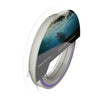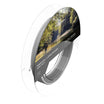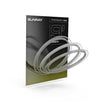We all know about the ‘induced take’ when fishing with nymphs thanks to Frank Sawyer & Oliver Kite. It is also obvious that streamers must have movement applied in order to imitate small fish. However, many fly fishers seem to either be unaware of or to ignore the application of movement to dry flies in order to induce the fish to take. To some extent it is a problem caused by folks like myself who keep publicising/promoting the need for a ‘dead drifted’ dry fly in order to achieve a perfect presentation that will fool wary trout & grayling. Whilst much of the time a ‘dead-drift’ is absolutely essential to make a dry fly behave naturally there are many situations where the application of subtle movements can make all the difference between failure to tempt our target fish or their capture. Let me recount a few instances where a ‘dead-drift’ may not be the best presentation.
At the time of writing the big Mayfly duns (Ephemera danica) are emerging on one of my local waters (Pickering Beck) & yesterday I had a couple of hours fishing in the late afternoon. It was cool, damp & dull & the flies were taking a bit of time to pull out of their nymphal shucks/exoskeletons due to the lack of solar energy, furthermore their low metabolic rate under such conditions meant that they struggled to lift off & many skittered & struggled across the river in an effort to become airborne. Whilst some of the over 30 fish that I caught fell to a ‘dead drift’ far more responded positively to a twitched Mayfly.

One to the twitched Mayfly.
In a few days time the female spinners of these Mayflies will be returning to the river to lay their eggs, after which they will fall to the river surface where they will twitch frequently during their death throes. The best presentation will then be to apply the subtle quivering motion to a suitable imitation.
Sedges/Caddis species that emerge at the river surface often skitter over the river surface in a similar manner to Mayfly duns & particularly at dusk when many species emerge a skated Elk Hair Caddis is a great fish catcher. Thinking of caddis I’ve mentioned in an earlier blog that tiny Agapetus pupae swim in the surface film to the river bank where they then transpose into the adults & a semi-dry Stuart Crofts Agapetus Pupa imitation is best fished ‘ dead-drift’ with frequent short pulls to simulate the natural.
Terrestrials such as beetles, grasshoppers, flying ants, hawthorn flies & the like all struggle to escape the entrapment of the surface film & again there are many times when I’ve found that the application of tiny twitches has induced an otherwise disinterested fish into aggressive action. A classic example of this was a couple of summers back when my friend Steve & I were fishing a heavily fished section of river in the middle of Cortina d’Ampezzo in Italy. The brown trout that could be clearly seen hugging the far bankside pockets in this fast flowing alpine river would follow & inspect a Foam Beetle that was ‘dead-drifted’ but would not take it. They had obviously seen a lot of ‘dead-drifted’ flies. Steve & I used combined tactics to fool these well-educated fish. One of us would position himself level with a visible fish whilst the other cast across the stream from a little upstream & drifted their fly downstream until when it was virtually level with the fish the spotter would shout ‘twitch it’. The fish’s response to the twitched fly was always an instantaneous grab before its prey could escape. I could recount a host of other instances where applying subtle movements to terrestrial dry flies has helped me to catch fish that have rejected the same fly ‘dead-drifted’, but I would just be gilding the lily.

Steve with a Cortina d‘Ampezzo trout.
Dragon Flies & Damsel Flies are another food item that trout prefer to be moving. A few times on small still waters I’ve come across rainbow trout taking Damsel Flies whilst in flight. Since I don’t keep a Blue Damsel pattern in my dry fly box I’ve just used a well-greased Daddy & skated it across the pond, to great effect.
Small still water rainbow that took a skated Daddy when Damsel Flies were flying.
My final examples took place firstly on the R. Tay in Scotland one early June day & secondly on the Cumbian Eamont one day in May. In both cases there was little fish activity to be seen but a few very large Stoneflies were skittering about over the river & every so often there was a huge disturbance as a trout chased & captured one. On the Tay I fished a size 10 F Fly with a CdC wing far longer than the body, whilst on the Eamont it was a similar sized Elk Hair Caddis. However in both cases I targeted any fish I saw rise & between times searched any features such as under overhanging branches, around submerged rocks & any other obvious places. By twitching & skating my flies I caught some big fish on both days, topped by wild brown trout of 3lb 1oz & 3lb 10oz on the Eamont.

3lb 10oz Eamont trout taken on a skated Elk Hair Caddis
So don’t just rely on the ‘dead-drift’ for your dry flies; be prepared to give them ‘life’ when you think it is appropriate.
































